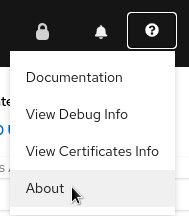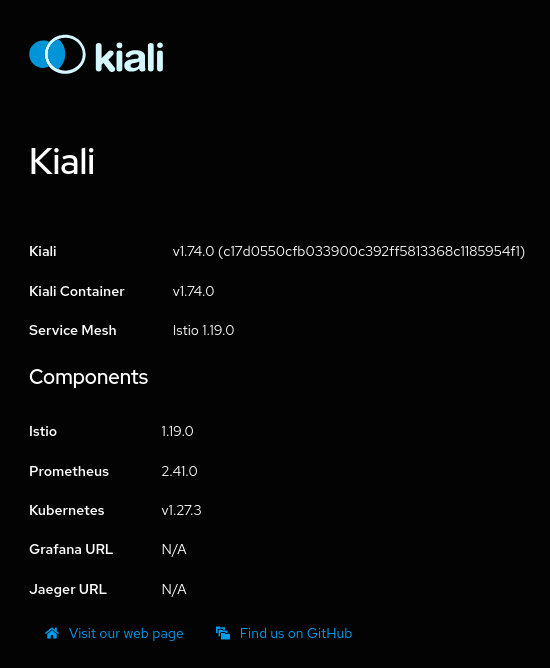General
How do I determine what version I am running?
There are several components within the Istio/Kiali infrastructure that have version information.
- Go to the Help dropdown menu found at the top-right of the Kiali Console window and select “About”. This will pop up the About box that will display all version information for Kiali, Istio, and other third-party components like Prometheus.
Help dropdown menu:

The Kiali About box:

- You can also get this same version information in JSON format from the command line by running something like
curlto obtain the version information from the/apiendpoint. For example, expose Kiali via port-forwarding socurlcan access it:
kubectl port-forward -n istio-system deploy/kiali 20001:20001
And then request the version information via curl:
curl http://localhost:20001/kiali/api
The version information will be provided in a JSON format such as this:
{
"status": {
"Kiali commit hash": "c17d0550cfb033900c392ff5813368c1185954f1",
"Kiali container version": "v1.74.0",
"Kiali state": "running",
"Kiali version": "v1.74.0",
"Mesh name": "Istio",
"Mesh version": "1.19.0"
},
"externalServices": [
{
"name": "Istio",
"version": "1.19.0"
},
{
"name": "Prometheus",
"version": "2.41.0"
},
{
"name": "Kubernetes",
"version": "v1.27.3"
},
{
"name": "Grafana"
},
{
"name": "Jaeger"
}
],
"warningMessages": [],
"istioEnvironment": {
"isMaistra": false,
"istioAPIEnabled": true
}
}
- Obtain the container image being used by the Kiali Server pod:
kubectl get pods --all-namespaces -l app.kubernetes.io/name=kiali -o jsonpath='{.items..spec.containers[*].image}{"\n"}'
This will result in something like: quay.io/kiali/kiali:v1.74.0
- Obtain the container image being used by the Kiali Operator pod:
kubectl get pods --all-namespaces -l app.kubernetes.io/name=kiali-operator -o jsonpath='{.items..spec.containers[*].image}{"\n"}'
This will result in something like: quay.io/kiali/kiali-operator:v1.74.0
- Obtain the container image being used by the istiod pod:
kubectl get pods --all-namespaces -l app=istiod -o jsonpath='{.items..spec.containers[*].image}{"\n"}'
This will result in something like: gcr.io/istio-release/pilot:1.19.0
- If Kiali and/or Istio are installed via helm charts, obtain the helm chart version information:
helm list --all-namespaces
As an example, if you installed Kiali Operator via helm, this will result in something like:
NAME NAMESPACE REVISION UPDATED STATUS CHART APP VERSION
kiali-operator kiali-operator 1 2023-09-26 09:52:21.266593138 -0400 EDT deployed kiali-operator-1.74.0 v1.74.0
Why is the Workload or Application Detail page so slow or not responding?
We have identified a performance issue that happens while visiting the Workload or Application detail page, related to discovering metrics in order to show custom dashboards. Both Kiali and Prometheus may run out of memory.
The immediate workaround is to disable dashboards discovery:
spec:
external_services:
custom_dashboards:
discovery_enabled: "false"
It’s also recommended to consider a more robust setup for Prometheus, like the one described in this Istio guide (see also this Kiali blog post), in order to decrease the metrics cardinality.
What do I need to run Kiali in a private cluster?
Private clusters have higher network restrictions. Kiali needs your cluster to allow TCP traffic between the Kubernetes API service and the Istio Control Plane namespace, for both the 8080 and 15000 ports. This is required for features such as Health and Envoy Dump to work as expected.
Make sure that the firewalls in your cluster allow the connections mentioned above.
Check section Google Kubernetes Engine (GKE) Private Cluster requirements in the Installation Guide.
Does Kiali support Internet Explorer?
No version of Internet Explorer is supported with Kiali. Users may experience some issues when using Kiali through this browser.
Kiali does not work - What do i do?
If you are hitting a problem, whether it is listed here or not, do not hesitate to open a GitHub Discussion to ask about your situation. If you are hitting a bug, or need a feature, you can vote (using emojis) for any existing bug or feature request found in the GitHub Issues. This will help us prioritize the most needed fixes or enhancements. You can also create a new issue.
See also the Community page which lists more contact channels.
How do I obtain the logs for Kiali?
Kiali operator logs can be obtained from within the Kiali operator pod. For example, if the operator is installed in the kiali-operator namespace:
KIALI_OPERATOR_NAMESPACE="kiali-operator"
kubectl logs -n ${KIALI_OPERATOR_NAMESPACE} $(kubectl get pod -l app=kiali-operator -n ${KIALI_OPERATOR_NAMESPACE} -o name)
Kiali server logs can be obtained from within the Kiali server pod. For example, if the Kiali server is installed in the istio-system namespace:
KIALI_SERVER_NAMESPACE="istio-system"
kubectl logs -n ${KIALI_SERVER_NAMESPACE} $(kubectl get pod -l app=kiali -n ${KIALI_SERVER_NAMESPACE} -o name)
Note that you can configure the logger in the Kiali Server.
Which Istio metrics and attributes are required by Kiali?
To reduce Prometheus storage some users want to customize the metrics generated by Istio. This can break Kiali if the pruned metrics and/or attributes are used by Kiali in its graph or metric features.
Kiali currently requires the following metrics and attributes:
| Metric | Notes |
|---|---|
| container_cpu_usage_seconds_total | used to graph cpu usage in the control plane overview card |
| container_memory_working_set_bytes | used to graph memory usage in the control plane overview card |
| process_cpu_seconds_total | used to graph cpu usage in the control plane overview card (if the container metric is not available) |
| process_resident_memory_bytes | used to graph memory usage in the control plane overview card (if the container metric is not available) |
Istio metrics and attributes:
| Metric | Notes |
|---|---|
| istio_requests_total | used throughout Kiali and the primary metric for http/grpc request traffic |
| istio_request_bytes_bucket | used in metric displays to calculate throughput percentiles |
| istio_request_bytes_count | used in metric displays to calculate throughput avg |
| istio_request_bytes_sum | used throughout Kiali for throughput calculation |
| istio_request_duration_milliseconds_bucket | used throughout Kiali for response-time calculation |
| istio_request_duration_milliseconds_count | used throughout Kiali for response-time calculation |
| istio_request_duration_milliseconds_sum | used throughout Kiali for response-time calculation |
| istio_request_messages_total | used throughout Kiali for grpc sent message traffic |
| istio_response_bytes_bucket | used in metric displays to calculate throughput percentiles |
| istio_response_bytes_count | used in metric displays to calculate throughput avg |
| istio_response_bytes_sum | used throughout Kiali for throughput calculation |
| istio_response_messages_total | used throughout Kiali for grpc received message traffic |
| istio_tcp_connections_closed_total | used in metric displays |
| istio_tcp_connections_opened_total | used in metric displays |
| istio_tcp_received_bytes_total | used throughout Kiali for tcp received traffic |
| istio_tcp_sent_bytes_total | used throughout Kiali for tcp sent traffic |
| pilot_proxy_convergence_time_sum | used in control plane overview card to show the average proxy push time |
| pilot_proxy_convergence_time_count | used in control plane overview card to show the average proxy push time |
| Attribute | Metric | Notes |
|---|---|---|
| connection_security_policy | istio_requests_total | used only when graph Security display option is enabled |
| istio_tcp_received_bytes_total | used only when graph Security display option is enabled | |
| istio_tcp_sent_bytes_total | used only when graph Security display option is enabled | |
| destination_canonical_revision | all | |
| destination_canonical_service | all | |
| destination_cluster | all | |
| destination_principal | istio_requests_total | used only when graph Security display option is enabled |
| istio_request_messages_total | ||
| istio_response_messages_total | ||
| istio_tcp_received_bytes_total | ||
| istio_tcp_sent_bytes_total | ||
| destination_service | all | |
| destination_service_name | all | |
| destination_service_namespace | all | |
| destination_workload | all | |
| destination_workload_namespace | all | |
| grpc_response_status | istio_requests_total | used only when request_protocol=“grpc” |
| istio_request_bytes_sum | ||
| istio_request_duration_milliseconds_bucket | ||
| istio_request_duration_milliseconds_sum | ||
| istio_response_bytes_sum | ||
| reporter | all | both “source” and “destination” metrics are used by Kiali |
| request_operation | istio_requests_total | used only when request classification is configured. “request_operation” is the default attribute, it is configurable. |
| istio_request_bytes_sum | ||
| istio_response_bytes_sum | ||
| request_protocol | istio_requests_total | |
| istio_request_bytes_sum | ||
| istio_response_bytes_sum | ||
| response_code | istio_requests_total | |
| istio_request_bytes_sum | ||
| istio_request_duration_milliseconds_bucket | ||
| istio_request_duration_milliseconds_sum | ||
| istio_response_bytes_sum | ||
| response_flags | istio_requests_total | |
| istio_request_bytes_sum | ||
| istio_request_duration_milliseconds_bucket | ||
| istio_request_duration_milliseconds_sum | ||
| istio_response_bytes_sum | ||
| source_canonical_revision | all | |
| source_canonical_service | all | |
| source_cluster | all | |
| source_principal | istio_requests_total | |
| istio_request_messages_total | ||
| istio_response_messages_total | ||
| istio_tcp_received_bytes_total | ||
| istio_tcp_sent_bytes_total | ||
| source_workload | all | |
| source_workload_namespace | all |
Envoy metrics:
| Metric | Notes |
|---|---|
| envoy_cluster_upstream_cx_active | used in workload details |
| envoy_cluster_upstream_rq_total | used in workload details |
| envoy_listener_downstream_cx_active | used in workload details |
| envoy_listener_http_downstream_rq | used in workload details |
| envoy_server_memory_allocated | used in workload details |
| envoy_server_memory_heap_size | used in workload details |
| envoy_server_uptime | used in workload details |
What is the License?
See here for the Kiali license.
Why isn’t my namespace in the Namespace Selection dropdown?
When deploying Kiali with the Kiali operator, by default some namespaces are excluded from the list of namespaces provided by the API and UI. Kiali filters out these namespaces and you will not see them in the Namespace Selection dropdown. You can adjust which namespaces are excluded by setting the spec.api.namespaces.exclude field on the Kiali CR.
In addition, you must ensure that Kiali has access to the namespaces you are interested in by setting the spec.deployment.accessible_namespaces field on the Kiali CR accordingly. Setting spec.api.namespaces.exclude alone does not give Kiali access to the namespaces. See the Namespace Management guide for more information.
Kiali also caches namespaces by default for 10 seconds. If the cache is enabled, it might take up to the spec.kubernetes_config.cache_token_namespace_duration in order for a newly added namespace to be seen by Kiali.
Finally, Kiali utilizes the Istio MeshConfig setting discoverySelectors - any namespace that does not match the discoverySelectors will not be available to Kiali users.
Workload “is not found as” messages
Kiali queries Deployment ,ReplicaSet, ReplicationController, DeploymentConfig, StatefulSet, Job and CronJob controllers. Deployment, ReplicaSet and StatefulSet are always queried, but ReplicationController, DeploymentConfig, Job and CronJobs are excluded by default for performance reasons.
To include them, update the list of excluded_workloads from the Kiali config.
# ---
# excluded_workloads:
# - "CronJob"
# - "DeploymentConfig"
# - "Job"
# - "ReplicationController"
#
An empty list will tell Kiali to query all type of known controllers.
Why Health is not available for services using TCP protocol?
Health for Services is calculated based on success rate of traffic. The traffic of HTTP and GRPC protocols is request based and it is possible to inspect each request to check and extract response codes to determine how many requests succeeded and how many erred.
However, HTTP is a widely known protocol. Applications may use other less known protocols to communicate. For these cases, Istio logs the traffic as raw TCP (an opaque sequence of bytes) and is not analyzed. Thus, for Kiali it is not possible to know if any traffic have failed or succeeded and reports Health as unavailable.
Why are the control plane metrics missing from the control plane card?
The control plane metrics are fetched from the Prometheus configured in Kiali.
Kiali will fetch the memory and the CPU metrics related to the Istiod container (discovery) first and will fallback to the metrics related to the istiod process if it couldn’t find the container metrics. If the required metrics are not found then Kiali can not display the related charts or data.
The metrics used are:
| Metric | Notes |
|---|---|
| container_cpu_usage_seconds_total | used for Istiod’s discovery container CPU metric |
| container_memory_working_set_bytes | used for Istiod’s discovery container memory metric |
| process_cpu_seconds_total | used for Istiod process CPU metric |
| process_resident_memory_bytes | used for Istiod process memory metric |